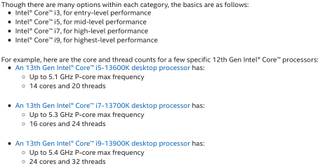Intel Publishes Specifications of Raptor Lake CPUs
Specs of unlocked Raptor Lake processors

Intel's 13th Generation Core 'Raptor Lake' processors are weeks away from their launch, when they're expected to join the ranks of the best CPUs for gaming. In the meantime, Intel (apparently accidentally) disclosed some of their specifications of unlocked parts on its own website, clearing some confusion created by various unofficial leaks.
On its ‘How to Choose a Gaming CPU’ page (discovered by @momomo_us) that gives some basic understanding about Intel’s CPU nomenclature and their capabilities, Intel revealed core counts and the P-core Max frequencies for its Core i5-13600K, Core i7-13700K, and Core i9-13900K processors. These are aimed at enthusiasts who dare to overclock their PCs and therefore need CPUs with unlocked multipliers. (Note that the post has since been updated to show 12th Gen CPUs.)
As expected, the Core i9-13900K features an impressive 24 cores (eight Raptor Cove high-performance cores and 16 Gracemont energy-efficient cores) in total and can process up to 32 threads simultaneously, the Core i7-13700K has 16 cores (8P+8E) and can process up to 24 threads at once, and the Core i5-13600K sports 14 cores (6P+8E) and can process up to 20 threads at once.

Perhaps more importantly, Intel disclosed P-core Max turbo frequencies of the unlocked 13th Generation Core processors for desktops: 5.40 GHz for the i9-13900K, and 5.30 GHz for the i7-13700K.
Intel's P-core Max is not the absolute maximum frequency that the company's modern CPUs can run on. For example, the Core i9-13900K will be able to work at 5.70 GHz in Turbo Boost Max 3.0 mode as well as at 5.80 GHz in Thermal Velocity Boost (TVB) mode, provided that they have enough power and appropriate cooling. Meanwhile, it looks like the top-of-the-range Core i9-13900KS will hit 6.0GHz, but we are speculating.
Intel doesn't normally pre-announce specifications of its upcoming products, though there might be reasons why Intel might want to publish some of Raptor Lake's specifications before launch. AMD is about to start selling its next-generation Ryzen 7000-series processors based on the Zen 4 microarchitecture and obviously Intel would like to steal some of AMD's thunder here. Also, the world's largest maker of CPUs might want to reaffirm that it plans to offer a 32-core processor for desktops just weeks after its arch-rival rolls-out its new 16-core Ryzen products.
While the page listing the specs has since been edited, the details aren't surprising and the cat — or dinosaur — is now officially out of the bag. Raptor Lake CPUs are rumored to launch on October 17.
Stay on the Cutting Edge
Join the experts who read Tom's Hardware for the inside track on enthusiast PC tech news — and have for over 25 years. We'll send breaking news and in-depth reviews of CPUs, GPUs, AI, maker hardware and more straight to your inbox.

Anton Shilov is a Freelance News Writer at Tom’s Hardware US. Over the past couple of decades, he has covered everything from CPUs and GPUs to supercomputers and from modern process technologies and latest fab tools to high-tech industry trends.
-
atomicWAR "it plans to offer a 32-core processor"Reply
Ahhh I think you mean 24 core 32 thread processor in your closing description of Raptor Lake's i9 13900k Vs AMD. 2nd to last paragraph. -
Sylwah Reply
I've been observing for some time: accuracy or fairness aren't exactly Anton's strong points. If tomshardware publishes an article bashing AMD chances are it's Anton. Not cool dude.atomicWAR said:"it plans to offer a 32-core processor"
Ahhh I think you mean 24 core 32 thread processor in your closing description of Raptor Lake's i9 13900k. -
atomicWAR ReplySylwah said:I've been observing for some time: accuracy or fairness aren't exactly Anton's strong points. If tomshardware publishes an article bashing AMD chances are it's Anton. Not cool dude.
I don't know that I'd call this article AMD bashing. The CPU core count mistake is an easy one to make and I have seen it made several times by other outlets...before (and after) Alder Lake launched we got a lot of 24 core misprints too on various sites. Just like I've seen AMD core count and thread count switched inadvertantly. Mistakes happen. All sites can get a fanboy or an over excited writer but as sites go Tom's is fair as fair gets IME. -
waltc3 Without power usage/performance per watt numbers, it won't have any effect on AMD's upcoming launches. I'm sure those were omitted deliberately at this stage...;) Should be an interesting October/November/December quarter! I'm interested in RDNA3, as well.Reply -
TerryLaze Reply
Well of course and it's the same reason they were omitted from the zen 4 cpus as well....THEY AREN'T OUT YET and the NDA is still in effect, nobody can release ANY specific info about either 13th gen or zen4.waltc3 said:Without power usage/performance per watt numbers, it won't have any effect on AMD's upcoming launches. I'm sure those were omitted deliberately at this stage...;) Should be an interesting October/November/December quarter! I'm interested in RDNA3, as well. -
closs.sebastien at tom's hardware... When does the 14-Gen come? I'm tired of seeing your low-quality "dinosaur-image-composition"Reply -
waltc3 ReplyTerryLaze said:Well of course and it's the same reason they were omitted from the zen 4 cpus as well....THEY AREN'T OUT YET and the NDA is still in effect, nobody can release ANY specific info about either 13th gen or zen4.
Zen4 ships with TDPs of 65W, 105W and 170W, depending on the CPU, with a max of 230W TDP SP at the high end. This was announced back at the Zen 4 reveal. The info should be easy to find--lots of official AMD slides on the subject. -
TerryLaze Replywaltc3 said:Zen4 ships with TDPs of 65W, 105W and 170W, depending on the CPU, with a max of 230W TDP SP at the high end. This was announced back at the Zen 4 reveal. The info should be easy to find--lots of official AMD slides on the subject.
So how are these numbers you post here telling us anything about power usage/performance per watt numbers?waltc3 said:Without power usage/performance per watt numbers,
Max power numbers don't tell you how much performance you will get.
And knowing the power it needed to get the Raptor up to 8Ghz doesn't tell you how much more performance they got out of it.
You need a performance number and the associated power number to figure out an efficiency. -
JamesJones44 Replywaltc3 said:Zen4 ships with TDPs of 65W, 105W and 170W, depending on the CPU, with a max of 230W TDP SP at the high end. This was announced back at the Zen 4 reveal. The info should be easy to find--lots of official AMD slides on the subject.
TDP is not power consumption. It tells you nothing about performance per watt. -
waltc3 ReplyTerryLaze said:So how are these numbers you post here telling us anything about power usage/performance per watt numbers?
Max power numbers don't tell you how much performance you will get.
And knowing the power it needed to get the Raptor up to 8Ghz doesn't tell you how much more performance they got out of it.
You need a performance number and the associated power number to figure out an efficiency.
You guys must've been asleep because improvements of up to 50% in performance per watt were all over the presentation--several slides showing different aspects of the same thing....;)
And talking about TDP numbers--where are Intel's?...;) That was my original point. You need to revisit the original reveal--AMD directly spoke to PPW often and emphatically.
Most Popular



